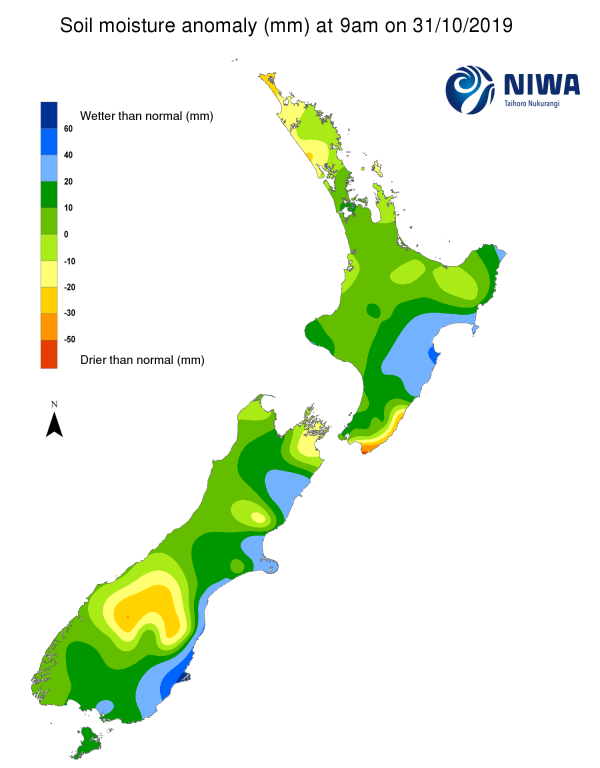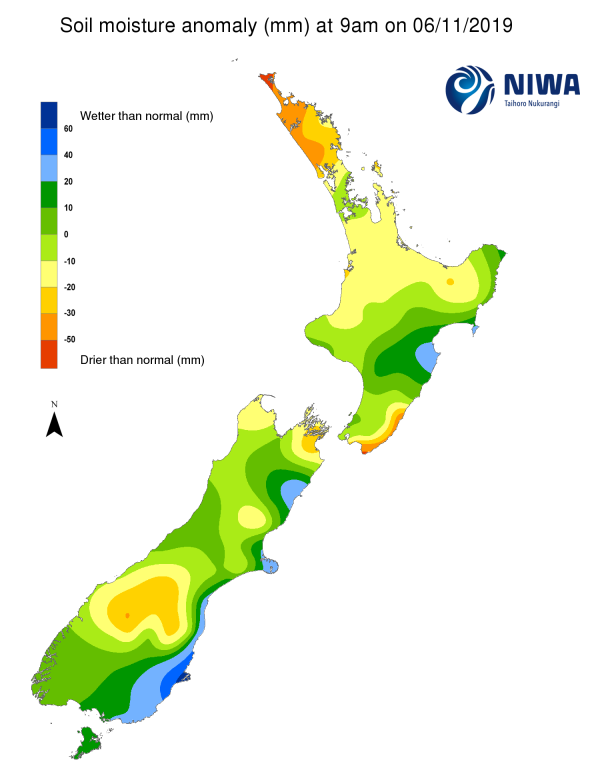A weekly update describing soil moisture across the country to help assess whether severely to extremely dry conditions are occurring or imminent. Regions experiencing these soil moisture deficits are deemed “hotspots”. Persistent hotspot regions have the potential to develop into drought.
Facts: soil moisture
Across the North Island, soil moisture levels decreased everywhere during the past week due to meagre rainfall and above average temperatures. The most significant decreases were observed across the northern half of the North Island, where soil moisture levels are now below normal nearly everywhere from Northland to Waikato and Bay of Plenty. The driest soils across the North Island compared to normal for this time of the year are now found near Cape Reinga and southernmost Wairarapa, while the wettest soils for this time of the year are located around Napier and Mahia Peninsula.
In the North Island, small hotspots are now in place at the top of Aupouri Peninsula and in far southern Wairarapa.
In the South Island, soil moisture levels decreased in most locations during the past week as rainfall was generally below normal and above to well above average temperatures were commonplace. Slight increases in soil moisture were observed along the southern Otago coast, however. The driest soils across the South Island compared to normal for this time of the year are found across far southern Canterbury, interior Otago, and the Marlborough Sounds, while the wettest soils for this time of the year are found in and around Dunedin.
Active hotspots in the South Island are currently located in interior southern Canterbury, the Queenstown-Lakes District, and the northeast coast of Marlborough.
Outlook and soil moisture
In the North Island, mostly dry weather will remain in place through early Saturday (9 November) as high pressure northeast of New Zealand retains control. However, a plume of moisture-rich subtropical air will arrive on Sunday and Monday (10-11 November), bringing moderate to even heavy rainfall to much of the North Island. In the upper North Island, some locations may see upwards of 40-50 mm of rain during this time, while lesser amounts are likely farther south. After a drying trend in the middle of next week, a front moving up from the South Island next Thursday (14 November) could deliver another 10-20 mm to western areas. Total rainfall in the next week could reach 40-60 mm in the upper North Island, 25-40 mm in the lower North Island, but only 15-20 mm along the East Coast.
Soil moisture levels are likely to improve in much of the upper North Island, while slight improvements are possible in the lower North Island. However, with less rainfall expected, the East Coast may see little change in the coming week. The current hotspot in the Aupouri Peninsula may disappear in the coming days, although little change is anticipated in southern Wairarapa.
In the South Island, a series of fronts will bring substantial rainfall to the West Coast through to Sunday (10 November), while 10-15 mm may also spill over into Southland and Otago. On Monday, low pressure may form off the coast of Canterbury, whose return flow could bring moderate rainfall to the eastern South Island. During the middle of next week, a couple more fronts will bring additional heavy rain to the West Coast and perhaps 10-15 mm to areas east of the Southern Alps. Total rainfall in the next week could exceed 200 mm in parts of the West Coast, with 20-40 mm possible in much of the eastern South Island.
With very heavy rainfall anticipated along the West Coast, soil moisture levels will increase substantially in the next week, but localised flooding will also be a concern. Expected rainfall amounts should also allow for at least small to moderate soil moisture increases in the eastern South Island. All of the current South Island hotspots are likely to weaken at least slightly in the coming week.
Background
Hotspot Watch: a weekly advisory service for New Zealand media. It provides soil moisture and precipitation measurements around the country to help assess whether extremely dry conditions are imminent.
Soil moisture deficit: the amount of water needed to bring the soil moisture content back to field capacity, which is the maximum amount of water the soil can hold.
Soil moisture anomaly: the difference between the historical normal soil moisture deficit (or surplus) for a given time of year and actual soil moisture deficits.
Definitions: “Extremely” and “severely” dry soils are based on a combination of the current soil moisture status and the difference from normal soil moisture (see soil moisture maps).
Hotspot: A hotspot is declared if soils are "severely drier than normal" which occurs when Soil Moisture Deficit (SMD) is less than -110 mm AND the Soil Moisture Anomaly is less than -20 mm.
Soil moisture anomaly maps, relative to this time of year. The maps show soil moisture anomaly for the past two weeks.
As of 4 November, the New Zealand Drought Index (NZDI) map below shows that drier than normal conditions are located across far southern Canterbury, a portion of interior Otago, and coastal Wairarapa. These areas will likely not change significantly in the coming week as rainfall will only be near or slightly above normal. Please note: some hotspots in the text above may not correspond with the NZDI map, mainly because the NZDI uses additional dryness indices including one which integrates the rainfall deficit over the past 60 days. Changes are therefore slower to appear in the NZDI compared to the instantaneous status maps of soil moisture anomaly.


